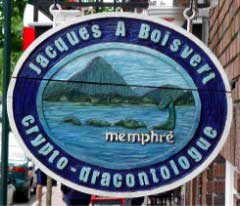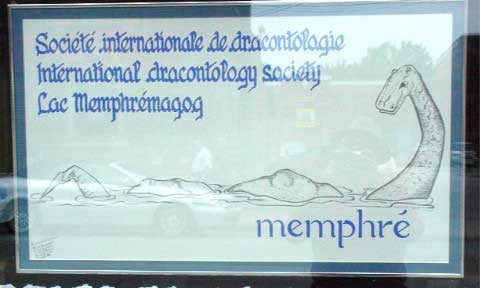|
The Man who Named Memphré
|
by Lois Wickstrom
Jacques Boisvert was born in Magog, Quebec, Canada, near the shore of Lake Memphrémagog. He never heard about the monster until 1978. Then he became curious. He scoured old newspapers and books. People had been seeing the monster for nearly 200 years, but nobody talked about it. Boisvert decided to keep reports of sightings. When he had 47 reports he went public. Now he has well over 200, which he is in the process of posting on his website at http://www.memphre.com
People who report seeing Memphré, have described everything from an unexpected trail in the water to a full head and humps description. Some people see just one hump, or two, or three. Local tribes have stories going back over a century warning children about bathing in the lake for fear of a monster. People have been seeing her at least once or twice a year for over 100 years. Some people have seen her two or three times. Boisvert thinks there's a family of monsters in the lake.
The most recent sighting on his website was recorded June 4, 2000 at 5 p.m:
I met at my office with Joanne, Serge, and Bruno Nadeau, who live in Sherbrooke, Quebec. They told me the following story, which I taped:
Around 2 p.m. today (4 June 2000) the lake (Memphremagog) was very calm; their boat was
anchored off the shore in Sergeant's Bay (where there are public moorings) when suddenly they saw what seemed to them an immense wave traveling in front of them, in a East-West direction. (they likened the wave to the wake produced by a boat with a 20 h.p. motor.) They said they saw a creature of approximately 75 feet long [which had] an immense head and tail. When the head came out [of the water] and re-entered, they could see the tail – this phenomenon was repeated 8-10 times.
The creature was brown and sleek, and moved rather quickly.
[It had] the head of an ox "... half as big ... similar to the head of a horse. They could see [movement] over a distance of approximately 2000 feet.
Nearby, there was a couple and when [I] shouted to them to look, the creature plunged and didn't return to the surface," said one of the witnesses. These three people confirmed they saw this phenomenon during 2.5 to 3 minutes."
He spells Memphré with the accent mark on the final e because that's how the lake is spelled. He's not taking a stand for a separate Quebec. In 1978 Boisvert had heart surgery and decided not to go back to work. He started talking to other people who had retired. Everybody had health problems. He decided he had to do something with his life to stay active. He took up scuba diving. Every day, he dives to the bottom of Lake Memphrémagog. In over 5000 dives, he's never seen the monster, but he's seen trails of dust, and felt a presence near him. He's also found numerous historical artifacts that have helped him with his second hobby – studying the history of Magog. He has found fossilized coral that is millions of years old. He has found Indian tribal pottery, and old lead sinkers from the days when fish traps were illegal.
Boisvert keeps one office for both his hobbies. The sign out front says The International Dracontology Society of Lake Memphrémagog. Where did he get the word dracontology?
"When I did begin researching the lake Memphremagog sea serpent I was in contact with a monk at the Benedictine Abbey of St-Benoît-du-Lac on the shores of Lake Memphremagog. I knew that the science that deals with the study of phenomenon of hidden animals was named CRYPTOZOOLOGY but I wanted to find a word that would identify the science dealing with unidentified strange lake dwelling creatures that could live in our lakes.
My friend, the Benedictine monk, a linguist, found the word :dracontologie, which was officially accepted by l'Office de la langue française du Québec on December 3rd 1984. We did have the english toponym (DRACONTOLOGY) accepted one year later by the American HeritageDictionary in the United States. in fact dracontology is part of cryptozoology. It was the only toponym that Dr. Heuvelmans, founder of cryptozoology, had accepted at the time." The society is International because the lake is international (both Canada and the United States.)
Boisvert is the founder and president of the Magog Historical Society. When he wants to make a decision or elect officers, he looks in the mirror for a show of hands. He likes to uncover discrepancies. The city of Magog celebrated its centennial in 1951. He couldn't find any records of Magog in 1851. According to his research the city was incorporated in 1888, so he convinced the city to have another centennial celebration in 1988.
He also likes to find parallels between Lake Memphrémagog and Loch Ness. Both are formed on northwest fault lines. Both have a Benedictine monastery nearby. Both had planes fall into them in 1942. Loch Ness is only 24 miles long, while Memphrémagog is 30 miles long. But Loch Ness is twice as deep as Memphrémagog. Boisvert considers himself more of a raconteur than a historian. In keeping with his sense of story, he records people's stories of sightings with audio tape and takes their pictures for his own records. He's still waiting to enter his own sighting into that record. He's sure she's there.
#
|
| For
more information on Memphre, visit:
http://magogquebec.homestead.com/memphre.html
|
 |
 |
 |
Jacques Boisvert, and signs from his shop in Magog,
Quebec, Canada
Obituary February 4, 2006
http://www.cryptomundo.com/cryptozoo-news/jacques-boisvert-obit/
|
|